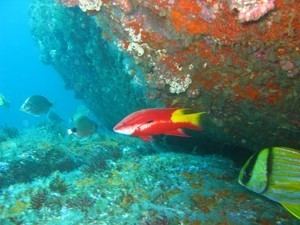Area 171 km² Established March 12, 1990 | ||
 | ||
Arvoredo Marine Biological Reserve (Portuguese: Reserva Biológica Marinha do Arvoredo) is a Biological reserve off the coast of the Santa Catarina state, Brazil.
Contents
Location
The Biological Reserve, which covers 17,104 hectares (42,260 acres), was established on 12 March 1990. It lies in the municipalities of Bombinhas, Florianópolis and Governador Celso Ramos of the state of Santa Catarina. The reserve is a transition region for seaweed flora, including organisms typical of both temperate and tropical regions. The reserve is close to the Subtropical Convergence where the Brazil Current from the north converges with the Falkland Current from the south. The surface waters are dominated by the Tropical Shelf Water while below 20 metres (66 ft) in depth the water is from the South Atlantic Central Water.
The Arvoredo archipelago (27°17' S; 48°28' W) is formed by three islands (Arvoredo, Galés and Deserta) and a rocky outcrop (São Pedro). The archipelago lies over the continental platform and is characterized by the presence of Precambrian crystalline rock shorelines. The depth throughout the archipelago varies from 5 to 25 metres (16 to 82 ft), rarely deeper than 30 metres (98 ft).
A few outcrops can be found in the region, such as Pedra Noceti, Parcel do Boi and Parcel da Deserta. The rocky habitat is characterized by many cavities formed by large boulders and medium-small sized pebbles covered with seaweed.
Conservation
The reserve is administered by the Chico Mendes Institute for Biodiversity Conservation. The reserve is classed as IUCN protected area category Ia (strict nature reserve). The purpose is to protect the biota and other natural attributes without human interference.
Protected species include the Starfish species Asterina stellifera, Astropecten brasiliensis, Astropecten marginatus, Coscinasterias tenuispina, Narcissia trigonaria and Oreaster reticulatus, loggerhead sea turtle (Caretta caretta), green sea turtle (Chelonia mydas), hawksbill sea turtle (Eretmochelys imbricata), olive ridley sea turtle (Lepidochelys olivacea), southern right whale (Eubalaena australis), La Plata dolphin (Pontoporia blainvillei), narrownose smooth-hound (Mustelus schmitti), Tube-dwelling anemone Cerianthomorphe brasiliensis, neon goby Elacatinus figaro, slate pencil urchin Eucidaris tribuloides, sea cucumber Isostichopus badionotus, decapod Minyocerus angustus, sea urchin Paracentrotus gaimardi, white-chinned petrel (Procellaria aequinoctialis), Atlantic yellow-nosed albatross (Thalassarche chlororhynchos) and black-browed albatross (Thalassarche melanophris).
